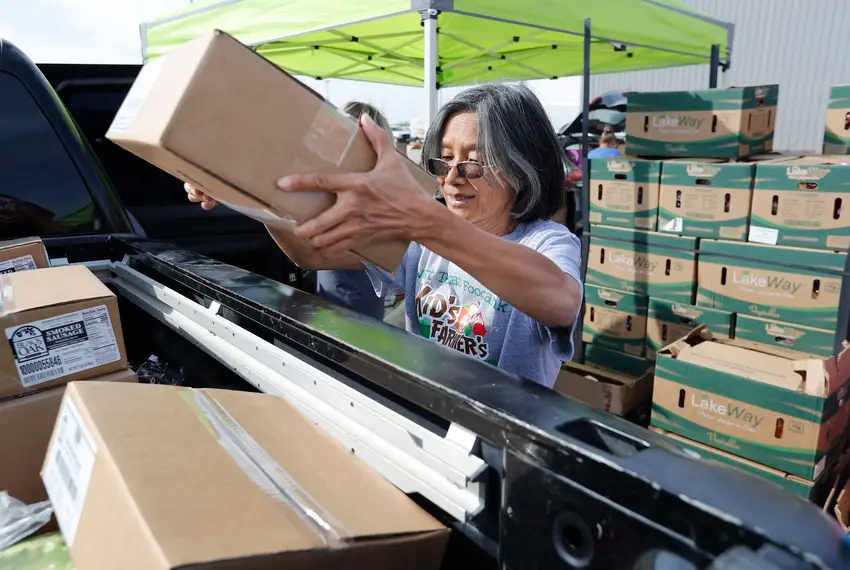
By Pooja Salhotra, The Texas Tribune
The number of Texans living in poverty slightly declined during the five-year period ending in 2022, though several rural counties saw their share of poor residents increase, according to new U.S. Census Bureau estimates.
An average of 13.9% of Texans lived below the poverty line from 2018 to 2022, down from 16% of Texans in poverty from 2013 to 2017. That decline mirrors a similar reduction in poverty levels nationwide as the share of Americans living in poverty fell from 14.6% to 12.5%.
The past five years encompassed a rollercoaster of an economic period as the COVID-19 pandemic abruptly stunted economic growth and was then followed by a slow period of recovery buoyed by federal child tax credits and infrastructure programs.
Texas also benefited from net domestic migration, with the state crossing a new threshold of 30 million residents last year. Those moving to Texas tend to be younger and more educated, according to the Federal Reserve Bank of Dallas, and therefore tend to boost the overall income level.
“If you look at why Texas came out ahead, it probably has to do with the vibrant economic activity and growth,” said Lloyd Potter, the state demographer. “And the fact that unemployment has been declining and is low.”
The U.S. Census Bureau’s poverty estimates come from the American Community Survey, which collects detailed data on population and housing. The survey measures poverty by comparing pre-tax income to a designated poverty threshold that is adjusted by family composition. In 2022, the poverty threshold for a family of four was $29,950. This poverty measure does not account for geographic differences in costs of living.
Despite the overall reduction in poverty rates statewide, 76 of Texas’ 254 counties experienced an uptick in poverty rates from 2018 to 2022. The vast majority of those counties are rural, with fewer than 50,000 residents. The largest increases occurred in rural counties including King, La Salle, Jeff Davis and Foard. Some of those counties’ poverty rates increased by double-digit margins. Local leaders attributed those increases to unemployment and an aging workforce.
Texas has the largest rural population in the country. Nearly 4.8 million people live outside a metro area in Texas, according to the latest Census Bureau estimates. And unlike the rest of the state, many rural Texas counties have been losing population. More than half of all Texas counties lost residents between 2010 and 2020, the majority of those being rural counties.
That’s because of a lack of job opportunities in rural areas. In Foard County, which is west of Wichita Falls, poverty rates have increased by more than 16 percentage points. County Judge Mark Christopher said that increase is likely driven by the growing number of retired people, who are all on fixed incomes that might not meet the poverty threshold. Christopher said he has noticed an uptick in the number of residents relying on the local senior citizens facility for meals each week.
“We are feeding more people,” Christopher said. “We’ve got about 80 to 100 people every Tuesday. It used to be less than 20 people.”
Food banks across the state have reported increased demands as federal funding for food programs have remained stagnant and high housing costs have left more Texans food insecure. Texas has one of the highest rates of food insecurity in the nation. Some 15.5% of Texas households lack consistent access to healthy and affordable food, according to a 2022 study from the U.S. Department of Agriculture.
In Dimmit County, which sits about 120 miles southwest of San Antonio, the poverty rate is the highest in the state, with 43.6% of residents living below the poverty line. That number is up from 30% over the previous five-year period.
According to Maribel Miranda, who runs the local food pantry, job opportunities are few and far between in Dimmit County. And most jobs do not pay well. Miranda said that since COVID, the number of people visiting the food pantry has increased exponentially, and has not gone down to pre-pandemic levels.
Potter, the demographer, said the new Census estimates highlight differing economic fates across the vast state.
“Texas is not a monolith,” Potter said. “In rural Texas, there are counties that are hurting.”
This article originally appeared in The Texas Tribune at https://www.texastribune.org/2023/12/15/texas-poverty-rate-census-2022/.
The Texas Tribune is a member-supported, nonpartisan newsroom informing and engaging Texans on state politics and policy. Learn more at texastribune.org.



